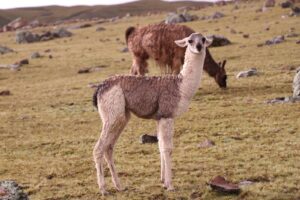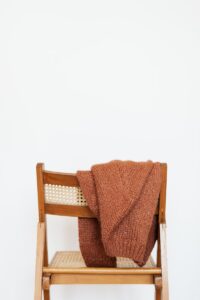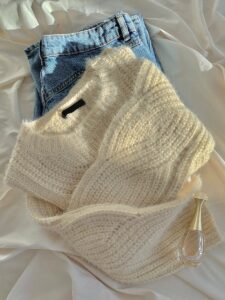When it comes to luxury fabrics, few can match the allure and exclusivity of vicuña wool. But why is vicuña wool so expensive? The answer lies in the unique blend of rarity, labor-intensive production, and unmatched quality. With only around 350,000 vicuñas left in the wild, these delicate creatures, found solely in the Andes mountains, are protected by strict conservation efforts.
Vicuñas can only be shorn once every three years, making their wool incredibly scarce. This scarcity, combined with the meticulous process of hand-harvesting the wool, significantly drives up its cost. Despite its high price tag, the fabric’s unparalleled softness and warmth make it a coveted choice for luxury fashion brands.
The cultural heritage of vicuña wool further enhances its value. Historically revered by the Incas as a symbol of royalty, this fabric continues to captivate modern designers, solidifying its status as one of the most prestigious materials available.
What Is Vicuña Wool?
Vicuña wool comes from the fleece of the vicuña, a small camelid native to the Andes Mountains. Known for possessing the finest fibers among all wool types, vicuña wool has a diameter of just 12 microns, even finer than cashmere. Renowned for its softness and warmth, it remains unmatched among luxurious fabrics. The wool’s exceptional properties are an outcome of the vicuña’s adaptation to the harsh alpine climates, making it a top choice for luxury garments.
Vicuna wool vs cashmere is a frequent topic in the luxury fashion world. While both are synonymous with elegance, vicuña fiber is significantly finer and rarer, contributing to its superior softness and exclusivity. Cashmere, although luxurious, cannot rival the cultural and historical prestige tied to vicuña wool.
Vicuñas are protected species, with conservation efforts led by the Peruvian government and surrounding countries safeguarding their numbers. Ethical vicuña wool sourcing involves controlled shearing processes, ensuring each animal is unharmed and can continue to contribute wool over its lifetime. The traditional Inca methods of shearing have been revived, which honor the ancient practice of capturing, shearing, and releasing the animals, aligning with sustainable and ethical standards.
Infused with cultural significance, vicuña wool was once reserved for Incan royalty. This historic association with prestige continues to shape its allure in the modern fashion industry. The labor-intensive gathering process and the wool’s rarity and quality contribute to why vicuña wool remains among the most luxurious and expensive in the world.
The Making of Vicuña Wool
Vicuña wool, cherished for its rarity and quality, requires a meticulous process for production. The delicate fibers, measuring only 12 microns, result in an exceptional fabric that stands out even among other luxurious fibers like cashmere.
Traditional and Modern Practices
Inca tradition deeply influences the harvesting of vicuña wool. During ancient times, community-driven practices involved capturing and releasing vicuñas after shearing, ensuring sustainability. This practice resurfaces today, with the current vicuña population benefiting from regulated shearing methods that emulate historical techniques.
Modern-day practices blend ancestral methods with contemporary standards to ensure ethical vicuña wool sourcing. The animals are carefully shorn to avoid distress, then released back into their high-altitude homes across the Andes Mountains. This controlled approach not only safeguards the sacred animal but also contributes to its conservation.
Challenges in Production
Producing vicuña fabric presents several challenges. First, the species’ status as an endangered species limits the frequency of shearing to once every three years, resulting in scarce wool availability. This infrequency, alongside labor-intensive processes, partially explains why vicuña wool is so expensive.
Another challenge lies in the harsh Andean environment where vicuñas live. The altitude, ranging from 12,000 to 16,000 feet, means that harvesting requires specialized knowledge and equipment to ensure both the safety of the workers and the animals.
Moreover, conservation rules strictly control the vicuña’s population to prevent poaching. These regulations ensure that the production of vicuña wool continues sustainably, balancing luxury market demands with ecological responsibility.
Unique Properties of Vicuña Wool
Vicuña wool is renowned for its unique combination of characteristics that contribute to its status as one of the most luxurious fabrics globally. Its extraordinary softness and warmth make it unparalleled in the realm of luxury textiles.
Softness and Warmth
The fibers of vicuña wool are incredibly fine, measuring just 12 microns in diameter, which explains why it’s softer than cashmere. This fineness allows the wool to provide a silky texture that feels smooth against the skin. In comparison to cashmere, the softness of vicuña wool creates an unrivaled tactile experience.
Additionally, the warmth provided by vicuña wool is exceptional. Adapted to the cold, harsh climates of the Andes Mountains, this wool insulates air effectively, maintaining warmth without adding bulk. This combination makes garments crafted from vicuña wool not only luxurious but also functional for various climates.
Rarity and Exclusivity
Vicuña wool’s rarity stems from several factors, including the limited population of vicuñas and their status as a protected species. Conservation efforts, led by the Peruvian government, are essential to maintaining sustainable populations of these South American camelids. These animals are ethically sourced and can be shorn only once every three years, ensuring minimal impact on their natural habitat and well-being.
The exclusivity of vicuña wool is further amplified by the labor-intensive shearing process, which adheres to age-old Inca traditions. This meticulous approach ensures that each fiber is harvested ethically, maintaining the high value associated with vicuña fabric. Its exclusiveness is a result of both its unmatched quality and ethical vicuña wool sourcing, positioning it among the most desired luxury materials.
Cost Factors of Vicuña Wool
The high cost of vicuña wool stems from its exclusivity and the meticulous production process. These factors, combined with its supreme quality, make it one of the most luxurious fabrics globally.
Limited Supply and High Demand
Vicuña wool is exceptionally rare, with each vicuña, a protected species in the Andes Mountains, only producing about 500 grams of wool every two to three years. The controlled shearing, managed by conservation guidelines, ensures ethical sourcing but contributes to its limited availability. This scarcity, coupled with high demand from luxury fashion markets, elevates its price significantly. The limited supply against growing demand creates a competitive market, where vicuña products like coats and sweaters become sought-after luxury items.
Comparisons with Other Luxury Fabrics
When comparing vicuña wool to other luxury fabrics such as cashmere or silk, vicuña fiber stands out due to its remarkable softness and warmth. Its fibers measure just 12 microns in diameter, finer than even baby cashmere, providing unparalleled comfort and insulation. While cashmere and merino offer similar qualities, they lack the exclusivity and cultural heritage tied to vicuña. Vicuña’s connection to Inca traditions adds a historical allure, setting its luxury status apart in the textile world.
- MY’S – Man You'll Succeed, grab a full 3-piece slim fit tuxedo set including a one-button jacket, matching vest, and pants. Each suit comes with a matching bow tie and is available in sizes XS to XXL. These tuxedos boast real pockets inside and out, highlighted with elegant chromed buttons, blending style, comfort, and affordability seamlessly. And hey, for every 5 suits purchased online, one is a MY’S suit!
- Top-notch Quality and Craftsmanship: At MY’S, we're all about top-tier quality in our men's tuxedos, using premium materials and meticulous craftsmanship. Our fabric exceeds industry standards, offering 30% more durability and breathability. We've got your comfort covered with larger shoulder pads and chest linings. Crafting our suits involves a detailed process of over 300 steps, reflecting the high standards showcased in our visuals and ensuring exceptional quality in every aspect.
- Contemporary Elegance and Unmatched Comfort: This tuxedo seamlessly combines style and comfort, offering a sleek, precisely tailored cut and 3D draping that flatters your appearance. With its stylish shawl lapel, it adds a touch of sophistication. Our focus remains on your comfort while keeping up with the latest trends. Perfected over 15 years, our tailoring techniques guarantee easy movement in all your activities—whether walking, driving, or dancing.
- Great for Any Occasion: Whether you're out casually or at special events like weddings and proms, this tuxedo effortlessly adapts to life's different occasions. It's not just for formal events; it's a perfect fit for everyday experiences—like enjoying nice dinners, attending social gatherings, or creating lasting memories. Versatile and stylish, it perfectly aligns with your lifestyle. Get ready for tons of compliments while feeling stylish and comfortable in any setting.
- Discover Your Perfect Fit: Check out our size chart in pictures 2 and 3 to find the ideal fit. Avoid the hassle and save money by getting the right size upfront. Unsure? Don't hesitate to reach out for sizing assistance. Simply provide your height, weight, chest, and waist measurements, and we'll ensure the fit is just right for you. At MY’S – Man You'll Succeed!
Historical and Cultural Significance
Vicuña wool’s historical importance dates back to pre-Columbian times when it was considered a precious asset in Andean communities. The Incas revered the vicuña, regarding it as sacred and exclusive to royalty. They valued its soft coat for weaving garments reserved for nobility, contributing to its present-day status among the most luxurious fabrics. This rich history adds cultural depth to its allure and influences its value in modern markets.
The Peruvian Andes serve as the vicuña’s native habitat where ancient traditions continue to influence ethical vicuña wool sourcing. Andean camelid shearing ceremonies, known as chaccu, represent a revival of these time-honored practices. Rooted in community engagement, these events ensure conservation and protection of this endangered species while respecting Inca tradition. Community efforts also highlight the animal’s status as a national treasure, maintaining its historical and cultural significance today.
Due to its historical ties, vicuña wool is more than just a material; it’s a symbol of cultural heritage that enhances its luxury appeal. The Peruvian government, along with local communities, plays a vital role in preserving this legacy by regulating sustainable and ethical practices. The luxurious vicuña fabric, valued for its exceptional softness and warmth, finds its place in high-end markets globally. Its rich background, coupled with remarkable properties, sets it apart from other luxury materials like cashmere, cementing its prominence in the textile world.
Ethical and Environmental Considerations
Ethical vicuña wool sourcing plays a crucial role in preserving vicuña populations. Conservation efforts in their native habitats like the Peruvian Andes protect these sacred animals from poaching. By adhering to sustainable practices, communities maintain balance between economic gain and species protection. The Peruvian government enforces strict regulations ensuring only controlled shearing during traditional ceremonies known as chaccu.
Sourcing vicuña wool ethically involves community-driven initiatives. These practices not only minimize the animals’ stress during shearing but also empower local Andean communities. By blending ancestral methods with modern safeguards, herders foster a respectful relationship with the environment. This commitment leads to sustainably harvested vicuña fiber that meets high ethical standards.
Environmental considerations focus on maintaining biodiversities within vicuña habitats. Vicuñas, a protected species, are integral to the ecosystem in regions they inhabit like the Andes Mountains in Peru and northern Chile. Conservation initiatives aim to preserve these delicate ecosystems while promoting vicuña wool as a luxurious yet environmentally conscious choice.
Final Thoughts: Why Is Vicuna Wool So Expensive
Understanding why vicuña wool is so expensive reveals a fascinating blend of rarity, tradition, and craftsmanship. This luxurious fabric’s high cost is justified by its exceptional qualities and the meticulous processes involved in its production. The dedication to ethical and sustainable practices ensures that vicuña wool remains a treasured material in the luxury fashion world. It’s more than just a fabric; it’s a symbol of cultural heritage and ecological responsibility. As demand continues to grow, the commitment to preserving both the vicuña species and their habitat remains crucial, making each piece of vicuña wool not only a luxury item but a testament to sustainable luxury.
Other suggested articles:




